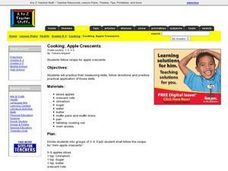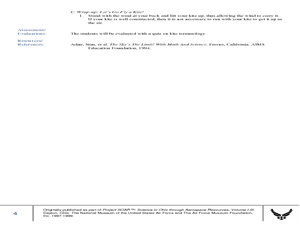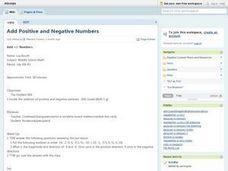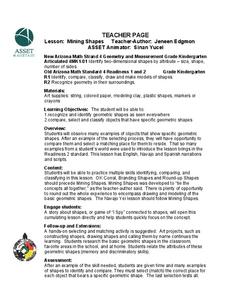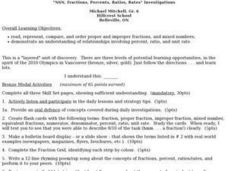Curated OER
Creative Factoring of Trinomials
Eighth graders consider an alternate method of factoring trinomials as opposed to guess and check. They can evaluate which method is easier and more appropriate for different problems.
Curated OER
Thank You... Thomas Edison!
Young scholars investigate the life of Thomas Edison. They research how he made a difference. They understand that accurate data collection is important for math. They create a chart using spreadsheet data.
Curated OER
Geo Jammin' By DeSign - Day 1, Lesson 5: Do You Hear What I Hear?
Students listen to a poem that includes directions to use geometric figures to complete a creative task.
Curated OER
Ratio and Probability
Fifth graders investigate the mathematical concepts of ratio and probability using created spinners and data collection techniques in this Math lesson for the fifth grade classroom. This lesson can be accomplished as an individual or...
Curated OER
Inverse Trigonometric Functions (Review)
Students investigate the concepts related to inverse trigonometric functions and then review the graphs for the inverse. They apply the functions using the context of the example problems provided in the lesson. The lesson includes...
Curated OER
Cooking: Apple Crescents
Student apply their measurement skills and follow a recipe to make apple crescents.
Curated OER
The Paper Dutch Kite
Students construct a Dutch Kite using simple materials. In this math lesson, students measure kite dimensions according to specified instructions. They also describe and define the different parts of a kite.
Curated OER
What percent of ratio is proportion?
Ninth graders investigate the concepts of ratio and proportion.They solve examples with the teacher for ratios and proportions. A basic fraction review is used for a warm up in this lesson. The primary focus of the lesson appears to be...
Curated OER
Interdisciplinary Lesson Plan- Math
Pupils perform locomotor movement. For this locomotor skills lesson, students practice running, hopping, skipping, and walking then form themselves into groups based on a number called out. Pupils identify if more or less...
Baylor College
Food for Kids
Immediately capture the attention of your class with the smell of freshly popped popcorn in the sixth lesson of this series on the needs of living things. Young scientists first use their senses to make and record observations of...
Baylor College
Fungus Among Us
In order to learn that mold spores can be found in the air, observers grow bread mold and make observations for a few days. Afterward, they participate in a class discussion to arrive at the knowledge that bread spores are present in the...
Baylor College
Breathing Machine
Take a deep breath and have your class construct working models of a lung! Using 500ml plastic bottles as the chest cavity, and balloons for the lung and the diaphragm, learners work in groups to make a model. The models help them to...
Insurance Zebra
Insurance Curriculum for Middle and High School Teachers
Liability, deductible, premium ... what do these words mean, and how do they relate to insurance? Scholars complete a pre-test, matching vocabulary activity, and insurance timeline worksheet and become familiar with these terms. Next,...
Curated OER
Add Positive And Negative Numbers
Scholars investigate the concept of adding positive and negative numbers. They practice adding using the number line for scaffolding. This can be done as a game for younger learners, but may also be helpful for engaging the older pupils.
Curated OER
Coordinate Geometry
Grab your class and get them graphing polygons on a coordinate plane! They investigate the four quadrants, discover the x and y axis, and correctly plot ordered pairs. To show their comprehension, each child creates a coordinate picture...
Curated OER
Estimating With Decimals
How can we estimate the answers when working with decimals? That's what the question is as the class reviews two-digit decimal addition. Have them estimate by rounding to a whole number either before or after they have completed their...
Curated OER
When Average Is the Way to Go
Students engage in experiences involving the mathematical concept of averages. After watching a video, students explore averaging through a variety of different methods.
Curated OER
Principles of Flight: Flying Paper Airplanes
Young scholars investigate ways to enhance an object's flying ability. In this model construction lesson, students construct two paper airplanes, one of which is twice as big as the first. Young scholars compare and contrast...
Arizona State University
Mining Shapes
Youngsters recognize and identify shapes. They draw, and use modeling clay to make shapes. They also identify shapes in their environment and in the Navajo culture, then compare the shapes and sort them into groups. This is the...
Curated OER
Vectors
High schoolers listen to a lecture and complete a number of problems as they go. There are a variety of examples given and they are guided through the problem solving steps for each of the real-world scenarios regarding the purpose of...
Curated OER
Inverse (Indirect) Machines
Students observe relationships between quantities. Students complete activities for three different classes of levers. In groups, students build each type of lever. Students identify levers in their daily surroundings. Students observe...
Curated OER
Mapping a Site Using a Coordinate Plane
Learners map their playground as if it were an archeological site. They locate objects on the playground and determine their location using coordinate points. A related lesson is Coordinate Grid: Mapping an Archeological Site.
Curated OER
Completing Simple Tax Forms
Twelfth graders practice filling out IRS 1040 EZ forms. They discuss various ways people pay taxes. They assess the importance of W-2 forms and apply skills using the IRS tax table to compute how much money is owed or returned.
Curated OER
"NSN, Fractions, Percents, Ratios, Rates" Investigations
Sixth graders engage in an investigation about the concepts related to fractions. They read, represent, compare, and order proper and improper fractions, and mixed numbers. They demonstrate an understanding of relationships involving...





